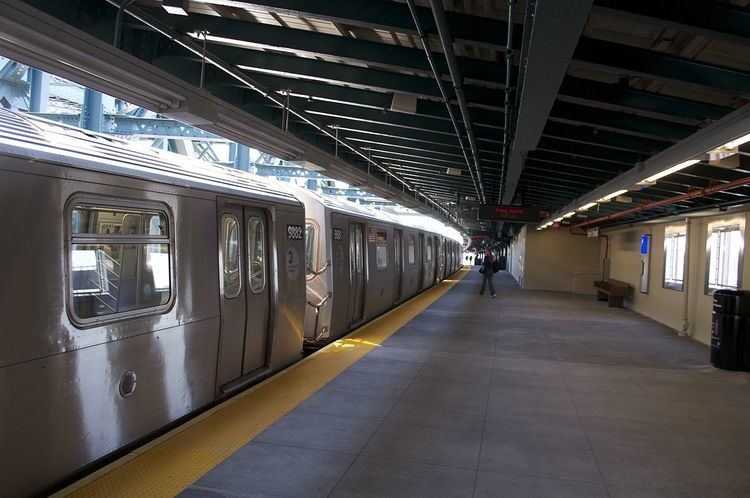Division B (IND) Transit connections NYCT Bus: B57, B61 Platforms 2 side platforms Borough Brooklyn Tracks 4 (2 in regular service) | Line IND Culver Line Structure Elevated Opened 7 October 1933 Locale Gowanus | |
 | ||
Services F (all times)
G (all times) Address Brooklyn, NY 11231, United States Similar Carroll Street, Hoyt–Schermerhorn Streets, Church Avenue, Bergen Street, Fort Hamilton Parkway | ||
Smith–Ninth Streets is a local station on the IND Culver Line of the New York City Subway. It is located over the Gowanus Canal between Smith and Ninth Streets in Gowanus, Brooklyn and is served by the F and G trains at all times.
Contents
This elevated station, opened on October 7, 1933, has four tracks and two side platforms. In 2009, the Metropolitan Transportation Authority began an extensive renovation of the station, which was closed entirely for a full reconstruction between June 2011 and April 2013.
History
In 1927, it was decided to build a bridge over the Gowanus Canal for the IND Culver Line, thus replacing earlier plans for a deep river tunnel in the area. This resulted in the only above-ground section of the original IND. The first short section of the line opened on March 20, 1933, from Jay Street to Bergen Street. The rest of the line, including the Smith–9th Streets station, opened on October 7, 1933, to the "temporary" terminal at Church Avenue.
Service patterns
The station was originally served by the A train. In 1936, the A was rerouted to the IND Fulton Street Line and E trains from the Queens Boulevard line replaced them. In 1937, the connection to the IND Crosstown Line opened and GG trains were extended to Church Avenue, complementing the E. In December 1940, after the IND Sixth Avenue Line opened, E trains were replaced by the F, and the GG was cut back to Smith–Ninth Streets. Following the completion of the Culver Ramp in 1954, D Concourse Express trains replaced F service to Coney Island. In November 1967, the Chrystie Street Connection opened and D trains were rerouted via the Manhattan Bridge and the BMT Brighton Line to Coney Island. F trains were extended once again via the Culver Line.
The station acted as a local-only station from 1968 to 1976, when F trains ran express in both directions between Bergen Street and Church Avenue during rush hours. The GG was extended from Smith–Ninth Streets to Church Avenue as a result of the express service's inauguration. Express service between Bergen and Church ended in 1976 due to budgetary concerns and passenger complaints, and the GG (later renamed the G) was again terminated at the station.
Renovation
In 2007, the MTA announced a three-year, $257.5 million renovation project of the elevated Culver Viaduct, and that for twenty-seven months, this station would be fully or partially closed for a $32 million renovation. The renovation was necessitated because the viaduct was falling apart, with leaks and broken concrete riddling the viaduct. The station and the portions of the viaduct near the station had to be encased in a mesh wrapping because there was a significant danger of concrete falling from the viaduct.
On July 5, 2009, the G was extended south at all times to Church Avenue, to allow for overhaul of the Culver Viaduct. On July 19, 2012, the MTA announced that this extension would be permanent.
On January 18, 2011, the second phase of the Culver Viaduct rehabilitation project began, resulting in the closure of the Manhattan-bound platform. This required northbound trains to use the express track and stop at a temporary platform placed over the local track. This shorter platform could only accommodate G trains; F trains bypassed this station on the same track. On June 20, 2011, the station was closed entirely for further renovations, to be reopened in December 2012. However, due to delays and cost overruns, It reopened on April 26, 2013. Additional work was performed after the station reopened but it did not affect service. Residents lobbied for an elevator in the station during the renovation, but a spokesman for the MTA said that installation of an elevator was too costly and prohibitive, and that such an elevator would have damaged the station's structural integrity.
Station layout
With an elevation of 87.5 feet (26.7 m), this station is the highest subway station above ground level in the world. This elevation was required by now-defunct navigation regulations for tall-mast shipping on the Gowanus Canal, so the bridge rises straight up on four towers by cables. West (railroad north) of this station, the IND Culver Line curves north and enters a tunnel into Carroll Street station. This station and the next station south, Fourth Avenue, were the only original elevated stations built by the IND. All other IND stations were either built underground or taken over from their original owners.
This station and elevated structure are made entirely of concrete. There were green mosaics along the concrete platform walls reading “Smith–9th St” in white sans-serif lettering, which were replaced with laminated replicas during renovations. A close examination of the canopied area suggests windows existed in the past. These were covered for many years and are now open air with safety grates. The station house is on ground level on the north side of 9th Street between Smith Street and the Gowanus Canal. Inside, there is a turnstile bank, token booth, and three long escalators and one staircase going up to a landing, where three more long escalators and one staircase perpendicular for the first set go up to a crossunder. A single staircase then goes up to the western end of either platform.
Exit
The station has a single exit on Ninth Street east of Smith Street.
